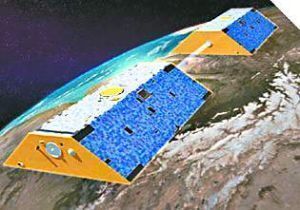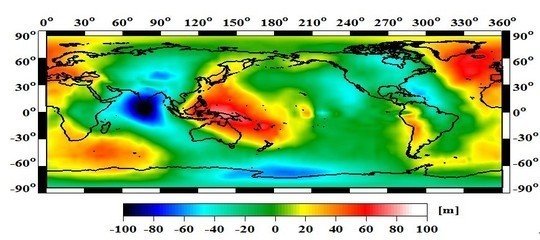
This is Scientific American 60 Seconds Science. I'm Cynthia Graberc. Got a minute?
这里是科学美国人60秒,科技频道。我是辛西娅·格拉勃克。
Want to know where—and when—the next major river flood will hit? Just look up, to the satellites.
想知道下一次大洪水什么时候发生,在那发生吗?抬起头,看看卫星你就知道了。
Conventional estimates of river volume come from rainfall, of course, and from measurement of the water that seeps from soil and groundwater reserves.
传统测量河流流量的方式主要是通过分析降雨量,土壤伸出的水量以及地下出水量得出的。
But NASA’s GRACE satellites, for Gravity Recovery and Climate Experiment, can pick up changes in the gravity field in a given river basin. The more water in the basin, the higher the gravity signal.
而美国国家航空航天局用于高精度观测全球重力场并进行气候变化试验的GRACE卫星可以检测到某一特定流域的重力场变化。该流域水量越大,重力场变化的信号越强烈。
 Scientists used GRACE results from 2003 to 2012 to see if they could have predicted the 500-year flooding event in the Missouri River basin in 2011. Preceding the flood were two significant storms, record snow melt, saturated soils and particularly high groundwater.With GRACE data, the researchers found that they could have predicted the Missouri River floods months before current prediction models. They say that the technique could be used to forecast floods up to 11 months before such events take place in areas where snow melt or groundwater is a significant contribution.
Scientists used GRACE results from 2003 to 2012 to see if they could have predicted the 500-year flooding event in the Missouri River basin in 2011. Preceding the flood were two significant storms, record snow melt, saturated soils and particularly high groundwater.With GRACE data, the researchers found that they could have predicted the Missouri River floods months before current prediction models. They say that the technique could be used to forecast floods up to 11 months before such events take place in areas where snow melt or groundwater is a significant contribution.
科学家试图通过分析GRACE卫星从2003年到2012年发来的数据信息检验GRACE卫星是否可以预测2011年发生在密苏里河流域的五百年年一遇的特大洪水。结果显示,在洪水来临以前,发生过两次特大暴雨,并伴有冰层融化,土壤饱和,高地下水等现象。通过对比,科学家发现,与现有的洪水预警仪器相比,GRACE卫星可以提前数月据预测出洪水的发生。如果某地区发生冰层融化或者高地下水显现异常严重时,GRACE卫星可以提前11个月就发出洪水预警。
The research was published in the journal Nature Geoscience.
该研究报告发表在“自然地球科学”杂志上。
Snow melt and major rain storms are predicted to increase with climate change. Which puts a premium on better flood prediction.
预测出冰层融化和暴雨也就能更好
Thanks for the minute for the Scientific American 60 Seconds Science. I'm Cynthia Graberc.
感谢收听,我是辛西娅·格拉勃克。 地预测洪水的发生。

 Scientists used GRACE results from 2003 to 2012 to see if they could have predicted the 500-year flooding event in the Missouri River basin in 2011. Preceding the flood were two significant storms, record snow melt, saturated soils and particularly high groundwater.With GRACE data, the researchers found that they could have predicted the Missouri River floods months before current prediction models. They say that the technique could be used to forecast floods up to 11 months before such events take place in areas where snow melt or groundwater is a significant contribution.
Scientists used GRACE results from 2003 to 2012 to see if they could have predicted the 500-year flooding event in the Missouri River basin in 2011. Preceding the flood were two significant storms, record snow melt, saturated soils and particularly high groundwater.With GRACE data, the researchers found that they could have predicted the Missouri River floods months before current prediction models. They say that the technique could be used to forecast floods up to 11 months before such events take place in areas where snow melt or groundwater is a significant contribution.










